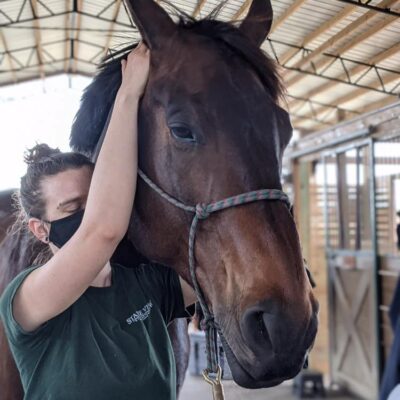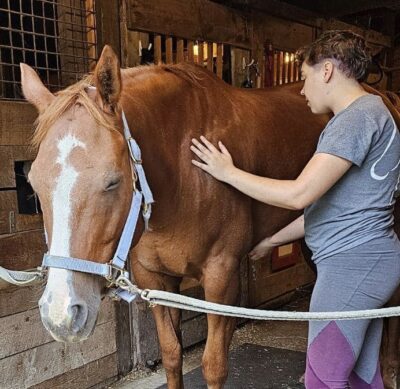single learning post
Collaboration Between Hoof Care Professionals & Equine Bodyworkers
In this webinar Saxon Alexandra will teach us how to interpret state veterinary laws to ascertain permitted bodywork therapies by state and to understand the distinction between equine manual bodywork modalities. We will learn to interpret the quality of training offered by various manual bodywork schools and identify green and red flags in a bodywork practitioner’s education, methods, goals, and business practices.

This webinar will help hoof care professionals feel more confident helping clients select a bodywork modality best suited to their horse and rehab goals.
Saxon Alexandra (they/them) is a non-binary, nationally-recognized equine structural integrator and massage therapist, and anatomy educator based in Vermont, United States.

Their resume in biochemistry includes lab tech work on projects examining the modulation of the mammalian circadian clock through extracellular protein signaling, optimizing organic pesticide development, and managing conservation genetics of protected ginseng populations.
After leaving academia to pursue more freedom for their gender expression, they rediscovered their childhood equine passion through grooming for FEI eventers, USEA stewarding, and rehabbing and retraining ex-racehorses in Aiken, SC.
This time in the sporthorse industry combined with their rigorous academic ethics training led Saxon to develop growing concern with modern sporthorse practices. After shadowing an equine osteopath and visiting The Equus-Soma Osteology center, they made the choice to pursue equine bodywork through The Equine Institute’s Advanced Equine Fascial Integration Therapy (EFIT) training program, pursue NBCAAM certification, and become more involved with the research and education work at Equus-Soma.
Saxon is the owner of Actuality Equine Structural Integration, and an educational docent and dissection team member with Equus-Soma Osteology and Anatomy learning center. Their goals in their practice are to empower equine guardians and professionals by making equine science education accessible.
Type Webinar
With Saxon Alexandra
When - 8:00 pm (EST)
Cost $35, $55 non-member
Credits 1
/ Status Currently unscheduled.
All clinics
- WTF – What the founder? Part 1
- Anatomy, Trimming and Hoof Protection – Colorado
- WTF – What the founder? Part 2
- Recognizing and Understanding the Role of Pain in Structural and Functional Asymmetries
- Hands-on Reading Radiographs for the Hoof Care Practitioner
- The Smart Way to Feed Horses – Part 1
- The Smart Way to Feed Horses – Part 2
- Reading Radiographs for the Hoof Care Practitioner
- Documenting Hoof Rehabilitation
- Anatomy, Trimming and Hoof Protection – New York
- Sustaining Your Hoof Care Business
- Advanced Anatomy and Radiographs – Colorado
- Anatomy, Trimming and Hoof Protection – California
- Off to a Good Start: Trimming Foals
- Anatomy, Trimming and Hoof Protection – Tennessee
- Advanced Anatomy and Radiographs – Tennessee
- Trimming Donkeys: Trimming Protocol, Hoof Distortion, and Laminitis
- Feeding Performance Horses
- Anatomy, Trimming and Hoof Protection – Florida
- Anatomy, Trimming and Hoof Protection – Quebec
- Advanced Anatomy and Radiographs – Quebec
- Feeding Pregnant and Growing Horses
- Feeding for Special Needs
- Hyperinsulinemia, Laminitis, and PPID: Diagnosis and Management
- How to Create and Manage Your Track System
- Limb Conformation, Body Posture and Hoof Capsule Distortions
- Dr. Bowker on Sound versus Healthy Hooves
- Changes in Coffin Bone Structure and Influence of Trimming
- Wear Patterns, What They Really Mean!
- Starting Your Hoof Care Business
- Dr. Tomas Teskey on the Equine Dental-Body Connection
- Choosing and Fitting Hoof Boots
- EMS (IR) and PPID: Diagnosis and Management
- Paige Poss Explores Hoof Distortions and Hoof Related Pain
- Utilizing Hoof Imaging in your Trimming Decisions
- Equine Biosecurity; It’s All About Prevention
- Genetics of Equine Metabolic Syndrome and Laminitis Risk
- Basics of Reading Radiographs
- NRC Plus
- Cushing’s and Insulin Resistance
All of our educational offerings are open to the public.

